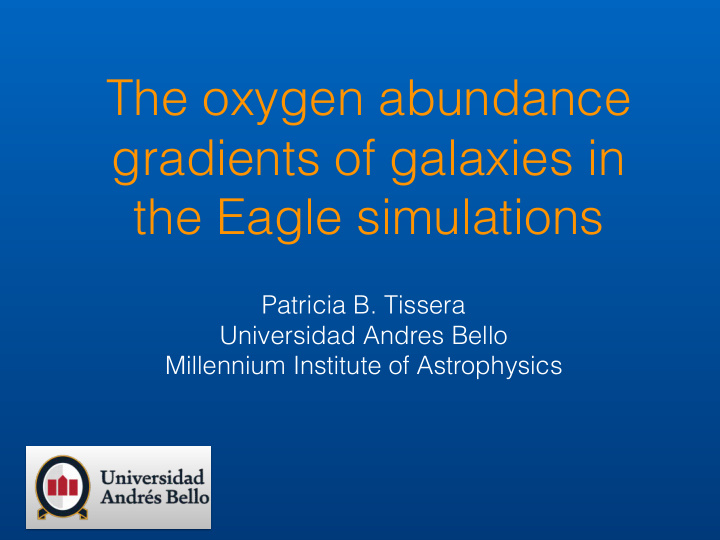



The oxygen abundance gradients of galaxies in the Eagle simulations Patricia B. Tissera Universidad Andres Bello Millennium Institute of Astrophysics
Metallicity gradients in disc galaxies What drives metallicity gradients in Ho+2015 discs ? Sanchez+2013; Sanchez-Mengano +2016 Belfiore+2017
Selected from 100 Mpc volume. At least ~2000 baryonic particles. Dynamical decomposition: O/H profiles determined for the disc components with at least 100 star forming regions. Local environment characterise by count-in-cell N CIC . Total sample of 592 simulated galaxies with a variety of morphologies in different environments. Y. Rosas-Guevara (UNAB), R. Machado (U. Curitiba), T. Theuns (ICC), R. Bowers (ICC), C. Lagos (Perth)
EAGLE simulations: global properties Three environments are defined: low (~100 members), intermediate (~300 members) and high (~100) density
Gas-phase abundances of disc galaxies: dependence on stellar mass
Gas-phase abundances of disc galaxies: dependence on stellar mass LM HM LM HM
Dependence on recent star formation history Discs with positive gas-phase metallicity gradients are found in galaxies which quenched the star formation activity before compared to those with negative in the same mass range. Galactic fountain are not efficiently working and could be a solution if they act in the central regions.
Dependence on recent merger history and D/T Galaxies selected not to have a recent merger event (1:10 & < 3Gyr) show a trend with stellar mass. They have D/T >0.5 on average. Galaxies selected by D/T > 0.5 and gas fraction > 0.15 show a trend with stellar mass. These galaxies show a larger dispersion for smaller masses.
Dependence on environment 45% 40% 27% Fraction of gas-rich galaxies (>15%) Fraction of galaxies with positive metallicity gradients Fraction of galaxies with recent mergers
Dependence on environment Tissera+2016 Ma+2017
Summary Metallicity gradients of the EAGLE discs are negative, on average, * albeit flatter than observations, S(OH) ~ -0.01 dex/kpc. Galaxies with no recent mergers determine a correlation with stellar * mass; they have well-defined discs and are gas-rich. Galaxies with a recent merger show a flat relation. There is a dependence of gas-phase metallicity gradients on local * environment since the merger rate and the gas fraction vary with environment. Results indicate too strong central outflows + weak impact of fountain accretion. On going work: evolution of the gas-phase metallicity gradients and the stellar metallicity gradients.
Recommend
More recommend